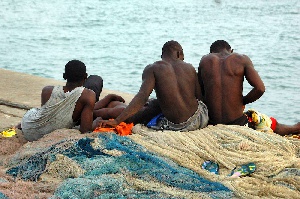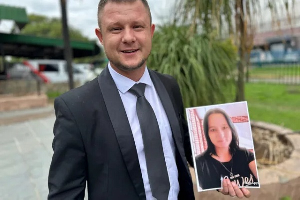This piece is a continuation of an article written by Citi FM’s correspondent, Obrempong Yaw Ampofo dubbed: “Polifishians’ and dwindling fish stock.” In that piece Obrempong chronicled some activities that has led to dwindling fish stock in most fishing communities in the country.
Below is the recent write-up: From Keta to Half Assini, fishing is becoming unattractive. Not because fishermen are abandoning canoes for classrooms, but nets cast return little or no fish. Perhaps, the “Sea Never Dry” mantra was an illusion! The stock of fish in the sea has steeply taken a downward decline.
Not even the Sardinella [Emane] and the Anchovies [Keta School Boys] that were largely produced in Ghana than other parts of the world are surviving. As a result, the livelihood of some 2.7 million people is threatened.
But, should anybody be surprised? No! Fishermen thought the adage, “Chew your eggs, and you are chewing your chicks” was applicable only to the farmer. And so when the farmer was reminded of the consequences when he eats ups his eggs, the fisherman was singing “Sea Never Dry.”
They have by their neglect fished the day old fish and the pregnant mother. Very cruel isn’t it? If this treatment was meted out to a mad human, the perpetrators might have been languishing in the deep belly of the Nsawam prisons! Fishing did not start today. But “chewing” of the day old and pregnant fishes can be traced. Fish catch since 1986.
Consider this: In 1986, a total of 190,197 metric tons of fish were caught between Keta and Half Assini by artisanal fishers. This was done with a total of 8,214 canoes. By year 2000, [14 years later] the number of canoes had reached 8,610, and the number of catch reached it all time record of 275,965mt. [Addition of 99,728mt to the 1999 catch of 176,237mt]. This was the end of glory for the Ghanaian artisanal fisherman.
The after mathematics is disturbing! In their quest to increase fish catch like the 2000, an astronomical 2,609 canoes were added in just four years [between 2000 and 2004] from 8,610 to 11,219 to the fleet of canoes from Keta to Half Assini. But, despite more canoes, fish catch kept dwindling.
It reduced to 267,910mt in 2004 from its 2000 record. [Reduced by 8055mt] The cycle kept dwindling when it dipped to 202,602mt in 2013. [A loss of 73,363 in 12 years] Still believing it was more canoes they needed to increase their catch rather than restocking or conservation of the stock, canoes numbers kept increasing from the 11,219 in 2004 to 12,847 in 2013.
[Addition of 1,628 canoes] [Source-Fisheries Management Plan of Ghana -2015-2019]. Even the 2015 figure of 11,213 artisanal canoes in Ghana, it is still above the recommended figure. Mention is not even made of the industrial fishers and their activities. The trawlers! Superheroes behind the infamous transshipment or “Saeco”! Add all the different fishing vessels, the semi industrial [240], the Trawlers [72 or 93?] and Tuna [37] and you have a total of 11,562.
But, from the figures, one thing is clear; as the fish stock is reducing, the number of canoes keeps increasing. Many canoes are therefore chasing fewer fishes in the sea. It is estimated that an excess 3,847 canoes are in the Ghanaian fishing space.
Only 9,000 canoes are recommended by international scientific agencies for Ghana. [But as at 2013, there were 12,847 artisanal canoes in Ghana]. This is the beginning of the advent of illegal fishing practices we are about to discuss. Fishing at the spawning grounds of fishes Picture a farmer sitting close to an egg laying hen with pan and cooking oil.
Anytime the hen lays one egg, the farmer fries it up. He enjoys but complains of low chicks in his pen. That has been the attitude of our fishermen! After finishing the catch at the shallow seas, fishermen headed for the deep belly of the ocean where many fish spawn at different seasons. Trawlers even go deeper.
Artisanal fishermen at this stage dip down light [Light for fishing] to the bottom of the sea which highly attracts majority of life in the ocean. When fishes, including those spawning for the next season gather around the light, unapproved fishing nets such as monofilament nets are casted wide. It traps all the surrounding fishes. In effect, little or no fish is left to spawn for the next season.
This has gone on for a very long time, culminating into the dwindling fish stock. Same reason is why August and September are no longer the fishing bumper seasons as we knew from infancy! Yet fishermen come back ashore to complain of low fish catch to us as if it’s someone else’s fault.
Use of chemicals After trapping both young and old with light, fishermen out of greed apply chemicals such as DDT, Carbide and dynamite at the concentrated area of the fish, killing every life. Now, they cast their nets wide to trap every dead fish.
By this, they make “good” catch. But, the chemical pollutes the space for a period of time. Now consider; fishermen at Jamestown are poisoning, those at Moree, Elmina, Anomabo, Dixcove and Axim etc are all doing same. They have been doing this for only God knows how long. Imagine the level of chemical concentration getting into the sea.
So someone traps your offspring, poisons and kills your family members and expects life later back in your home. Consider also, the chemical concentration in the fishes we have been eating. It is not for nothing that some fishes are brought ashore with reddish and sunken eyes and broken flesh. It is a testimony that the fishes were caught illegally and cruelly. The practice poses greater health risk to consumers.
Some of the chemicals may be bio accumulating in our tissues, first in the tissues of the fish, and then it’s transferred into our own tissues which affect our nervous system. Blame the fishermen for the dwindling fish stock! Transshipment or “Saeco” Transshipment is forbidden in Ghana. It is perpetrated largely by trawlers with their local counterparts. As at 2013, their numbers had increased from 58 in 1986 to 115.
Even though there are conflicting figures of their current number, it reduced to 72 or 93 in 2015. Thank God! These trawlers go to the bottom of the ocean to catch big fishes.
By their operations, they will catch small fishes at shallow waters. The law allows 15 percent of their total catch per trip to be small fishes. But, the Chinese operators of many of the trawler vessels and their co Ghanaians on board engage in shallow fishing. When many smaller fishes are caught, a canoe is called from the shore to the sea to buy the fishes and leaves approximately the 15 percent onboard.
So a canoe goes to sea without net but returns with fish. Here too, blame the fishermen. They see their colleagues go fishing without nets, but no one raises alarm.
Saeco has somehow gained grounds in the Ghanaian fishing industry. If trawlers are allowed to engage in this practice, their activity will finish up the remaining stock. These and other practices have been allowed to go on in the Ghanaian waters. In the next article, we will consider how you and I on land are to blame for the decline in fish stock.
Opinions of Thursday, 16 June 2016
Columnist: Obrempong Yaw Ampofo
Keta songs, Half Assini prayer and the canoe’s holiday
Entertainment














